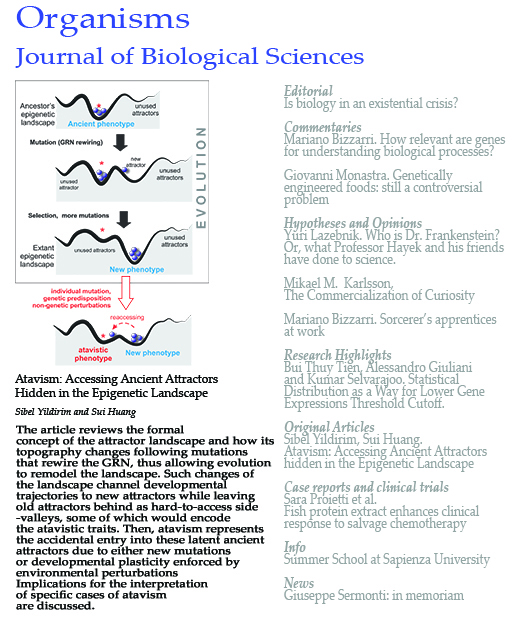Atavism: Accessing Ancient Attractors Hidden in the Epigenetic Landscape
DOI:
https://doi.org/10.13133/2532-5876_4.7Abstract
Atavism, the reappearance of an ancestral trait in an individual organism of a species that lacks that trait, such as hind-legs in whales or teeth in chicken, is considered an accident of development. But far from a destructive error, it manifests a stunningly complex, organized structure indicative of a creative-constructive process. The contradiction between rarity of an accident and rule-obeying nature of a common, yet sophisticated anatomical form remains a challenge for the common explanation that atavism results from genetic mutations that reactivate evolutionarily silenced developmental genes in the genome. Here we propose that an atavistic trait can be understood as the re-accessing of a remnant ancient attractor in the high-dimensional dynamics of the gene regulatory network (GRN) not meant to be occupied. Attractors are stable configurations of gene expression patterns, represented by “potential wells” in a quasi-potential landscape, which in turn is the mathematical equivalent to Waddington’s epigenetic landscape. This article reviews the formal concept of the attractor landscape and how its topography changes following mutations that rewire the GRN, thus allowing evolution to remodel the landscape. Such changes of the landscape channel developmental trajectories to new attractors while leaving old attractors behind as hard-to-access side-valleys, some of which would encode the atavistic traits. Then, atavism represents the accidental entry into these latent ancient attractors due to either new mutations or developmental plasticity enforced by environmental perturbations. Implications for the interpretation of specific cases of atavism are discussed.Downloads
Published
How to Cite
Issue
Section
License
Copyright Agreement with Authors
Before publication, after the acceptance of the manuscript, authors have to sign a Publication Agreement with Organisms. The authors retain all rights to the original work without any restrictions.
License for Published Contents

You are free to copy, distribute and transmit the work, and to adapt the work. You must attribute the work in the manner specified by the author or licensor (but not in any way that suggests that they endorse you or your use of the work).





